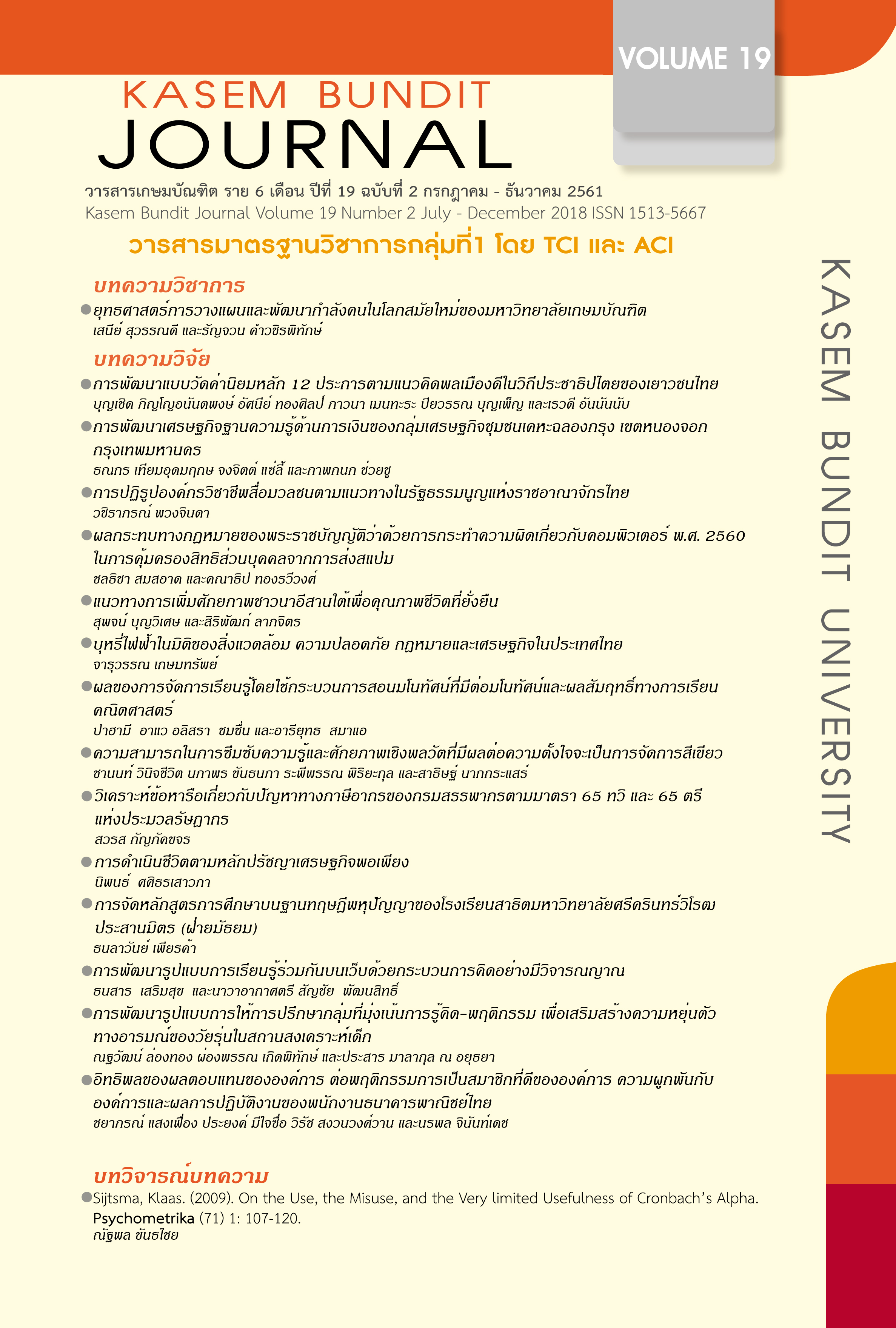E-cigarettes as Environmental, Safety, Laws and Economic Dimensions in Thailand
Keywords:
บุหรี่ไฟฟ้า สิ่งแวดล้อม ความปลอดภัย กฎหมาย เศรษฐกิจAbstract
จากข้อมูลประชากรที่มีอายุ 15 ปีบริบูรณ์ขึ้นไปในปี พ.ศ. 2557 จำนวน 54.8 ล้านคน พบว่าเป็นผู้ที่สูบบุหรี่ธรรมดา (Conventional Cigarettes) 11.4 ล้านคน โดยส่วนใหญ่เป็นผู้ที่สูบบุหรี่เป็นประจำ 10 ล้านคน และเป็นกลุ่มวัยทำงานที่มีอายุ 25 - 59 ปี ในปริมาณร้อยละ 23.5 ทั้งนี้ผู้ชายมีการสูบบุหรี่มากกว่าผู้หญิง 18.4 เท่า ซึ่งการสูบบุหรี่ทำให้เกิดโรคมะเร็ง โรคหัวใจ โรคถุงลมโป่งพอง ในขณะเดียวกันปริมาณการสูบบุหรี่ไฟฟ้า (E-Cigarette) มีมากขึ้น โดยผู้สูบส่วนใหญ่มีความเชื่อว่าบุหรี่ไฟฟ้าปลอดภัยมากกว่าและสามารถช่วยเลิกการสูบบุหรี่ธรรมดาได้ อย่างไรก็ดีบุหรี่ไฟฟ้าเป็นอุปกรณ์นำส่งนิโคตินด้วยระบบอิเล็กทรอนิกส์ (ENDS: Electronic Nicotine Delivery System) ซึ่งประกอบด้วย แบตเตอรี่ (Battery) อุปกรณ์ที่ทำให้เกิดความร้อนเพื่อเปลี่ยนน้ำยาให้เป็นละอองไอ (Atomizer) ถังบรรจุน้ำยาหรือลำกล้อง (Cartridge) และก้นกรอง (Cartomizer) โดยส่วนผสมที่พบมากในน้ำยา (E-Liquid หรือ E-Juice) ได้แก่ นิโคติน (Nicotine) โพรไพลีนไกลคอล (Propylene Glycol) กลีเซอรีน (Glycerine) อาจจะเป็นอันตรายอย่างเฉียบพลันและระยะยาวจากการสูดดมไอระเหย (Vaping) นอกจากนี้บุหรี่ไฟฟ้าที่ถูกทิ้งในพื้นที่สาธารณะจะกลายเป็นของเสียอันตราย (Hazardous Waste) และสามารถเกิดระเบิดและอุบัติเหตุเพลิงไหม้ได้ ดังนั้นหน่วยงานภาครัฐจึงนิยามให้บุหรี่ไฟฟ้าเป็นสินค้าควบคุมและบังคับใช้ในพระราชบัญญัติควบคุมผลิตภัณฑ์ยาสูบ พ.ศ. 2560 แทนที่พระราชบัญญัติควบคุมผลิตภัณฑ์ยาสูบ พ.ศ. 2535 และพระราชบัญญัติคุ้มครองสุขภาพผู้ไม่สูบบุหรี่ พ.ศ.2535 ซึ่งไม่สัมฤทธิ์ผลในการคุ้มครองสุขภาพอนามัยของประชาชน อีกทั้งประเทศไทยได้เข้าเป็นภาคีของกรอบอนุสัญญาว่าด้วยการควบคุมยาสูบขององค์การอนามัยโลก ดังนั้นการขับเคลื่อนทางสังคมและสิ่งแวดล้อมควรเผยแพร่ข้อมูลในเรื่องความเสี่ยงและอันตรายจากการใช้บุหรี่ไฟฟ้า ควรใช้นโยบายบังคับและเพิ่มภาษี เพื่อควบคุมการสูบบุหรี่ไฟฟ้า และควรเพิ่มการศึกษาในด้านผลกระทบทางสิ่งแวดล้อมจากบุหรี่ไฟฟ้ามือสอง และมือสามให้มากขึ้น
References
American Industrial Hygiene Association. (2014). Electronic Cigarettes in the Indoor Environment. Indoor Environmental Quality Committee and Risk Assessment Committee.
Clive Bates Counterfactual Consulting and Advocacy. (2015). E-cigarettes, Vaping and Public Health A Summary for Policy-makers.
Consumer Protection Committee. (2015). Ban for Sale and Service “Baraku, Electronic Baraku or Electronic Cigarette or Baraku Liquid, Electronic Baraku liquid or Electronic Cigarette Liquid”, Thailand.
Dawkins, L., McRobbie, H. (2017). Changing behaviour: Electronic Cigarettes, The British Psychological Society Promoting Excellence in Psychology.
Drummond, M. B. and Upson, D. (2014). Electronic Cigarettes Potential Harms and Benefits, AnnalsATS, Volume 11(2), 236-242.
Dhippayom, T. and Nimpitakpong, P. (2014) “Electronic Cigarette.” Journal of Public Health, Volume 44(3), 313-328.
Ernst and Young LLP (2016), E-cigarettes: an Emerging Category, UK.
Farsalinos, K.E., Romagna, G., Tsiaoras, D., Kyrzopoulos, S. and Voudris, V. (2013) “Evaluation of Electronic Cigarette Use (Vaping) Topography and Estimation of Liquid Consumption: Implications for Research Protocol Standards Definition and for Public Health Authorities’ Regulation” International Journal of Environmental Research and Public Health, Volume 10, 2500-2514.
Payne, J. D., Orellana-Barrios, M., Medrano-Juarez, R., Buscemi, D. and Nugent, K. (2016)., Electronic Cigarettes in The Media. Proc (Bayl Univ Med Cent), 29(3): 280–283
Goniewicz, M.L., Knysak, J., Gawron, M., Kosmider, L., Sobczak, A., Kurek, J., Prokopowicz, A., Jablonska-Czapla, M., Rosik-Pulewska, C., Havel, C., Jacob, P. and Benowitz, N. (2013) “Levels of Selected Carcinogens and Toxicants in Vapour from Electronic Cigarettes.” Tob Control, 1–7.
Hartung, T. (2016) “E-Cigarettes and the Need and Opportunities for Alternatives to Animal Testing, Food for Thought ...” ALTEX, Volume 33(3), 211-224.
Hardcastle, K., Hughes, K. and Worsley, J. (2014). Most people I know have got one”: Young people’s perceptions and experiences of electronic cigarettes” Centre for Public Health, Liverpool John Moores University.
Krause, M.J.and Townsend, T.G. (2015) “Hazardous Waste Status of Discarded Electronic Cigarettes.” Waste Management, Volume 39, 57-62.
Lerner, C.A., Sundar, I.K., Watson, R.M., Elder, A., Jones, R., Done, D., Kurtzman, R., Ossip, D.J., Robinson, R., McIntosh, S. and Rahman, I. (2015). Environmental Health Hazards of E-cigarettes and Their Components: Oxidants and Copper in E-cigarette Aerosols. Environmental Pollution, Volume 198, 100-107.
McAuley, T. R., Hopke P. K.., Zhao J. and Babaian S. (2012) “Comparison of the Effects of E-cigarette Vapor and Cigarette Smoke on Indoor Air Quality.” Inhalation Toxicology, Volume 24(12), 850–857.
Mckeganey, N., Barnard, M. and Russell, C. (2016) “Visible Vaping: E-Cigarettes and the Further De-Normalization of Smoking.” International Archives of Addiction Research and Medicine, Volume 2(3), 1-6.
Mckeganey, N. and Dickson, T. (2017) “Why Don’t More Smokers Switch to Using E-Cigarettes: The Views of Confirmed Smokers.” International Journal of Environmental Research and Public Health, Volume 14(647), 1-12.
Mckenna, L.A.Jr. (2017). Electronic Cigarette Fires and Explosions in the United States 2009 – 2016, Research Group National Fire Data Center U.S. Fire Administration.
National Statistical Office of Thailand. (2015) “Increasing of Alcohol and Cigarette in Thais.” Interesting Statistic Information, Volume 26(1), 4.
Palazzolo, D.L. (2013). “Electronic Cigarettes and Vaping: A New Challenge in Clinical Medicine and Public Health. A Literature Review, Frontiers in Public Health.” Public Health Education and Promotion, Volume 1(56), 1-20.
Pisinger, C. (2015). A Systematic Review of Health Effects of Electronic Cigarettes. World Health Organization.
Protano, C., Milia L.M.D., Orsi G.B. and Vitali, M., (2015)., Electronic cigarette: a threat or an opportunity for public health? State of the art and future perspectives. Clin Ter, Volume 166(1): 32-37.
Prutipinyo, C. (2015). “Comprehensive Tobacco Control Laws and Policies.” Public Health & Health Laws Journal, Volume 3, 254-271.
Schober, W., Szendrei, K., Matzen, W., Osiander-Fuchs, H., Heitmann, D., schettgen, T., Jörres, R.A. and Fromme, H. (2014), Use of electronic cigarettes (e-cigarettes) impairs indoor air quality and increases FeNO levels of e-cigarette consumers, International Journal of Hygiene and Environmental Health, Volume 217: 628–637.
Smoking & Health Action Foundation (2017). E-Cigarette Update: Secondhand Vapour Toxicity and Health Effects, Non-Smokers’ Rights Association, Thailand.
U.S. Department of Health and Human Services. (2016). E-Cigarette Use Among Youth and Young Adults: A Report of the Surgeon General: National Center for Chronic Disease Prevention and Health Promotion, Office on Smoking and Health, USA.
Usaha, J., Kanvihok, T., Chulasareekul, S. and Harerhanspong, V. (2015). Meta Synthesis of Preventive Factors for Cigarette Smoking Among Thai Youths. Department of Disease Control, Ministry of Public Health, Thailand.
Viscusi, W. K., (2016) “Risk Beliefs and Preferences For E-Cigarettes.” American Journal of Health Economics, Volume 2(2), 213–240.
Wang, P., Chen, W., Liao, J., Matsuo, T., Ito, K., Fowles, J., Shusterman, D., Mendell, M., Kumagai, K. (2017), A Device-Independent Evaluation of Carbonyl Emissions from Heated Electronic Cigarette Solvents, PLOS ONE.
Wang, L., Zhan, Y., Li, Q., Zeng, D.D., Leischow, S.J. and Okamoto, J. (2015) “An Examination of Electronic Cigarette Content on Social Media: Analysis of E-Cigarette Flavor Content on Reddit, International Journal of Environmental Research and Public Health.” Volume 12, 14933-14952.
Downloads
Published
How to Cite
Issue
Section
License
ทัศนคติ ความคิดเห็นใด ๆ ที่ปรากฏในวารสารเกษมบัณฑิตฉบับนี้เป็นของผู้เขียน โดยเฉพาะ มหาวิทยาลัยเกษมบัณฑิตและบรรณาธิการ ไม่จำเป็นต้องมีความเห็นพ้องด้วย







